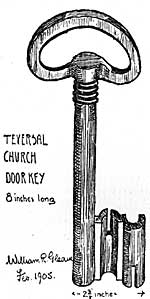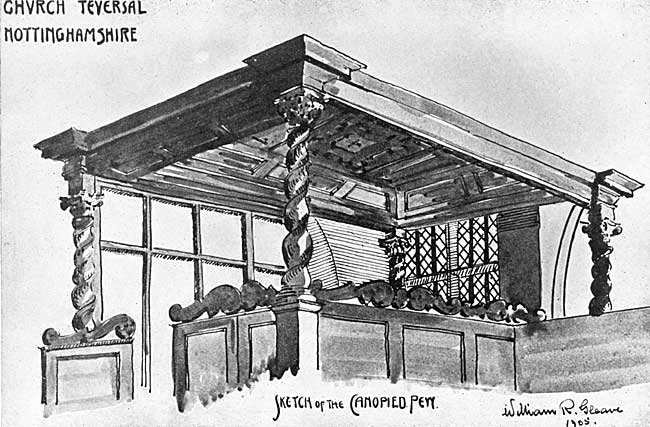
There are also some square manor-house windows, with their original fittings in this aisle. They seem strangely out of place. But they are all either of the same date or are later imitations of a manor-house window in the south aisle, above which are the initials I. M. and the date 1684, underneath which is the Molyneux cross.
In the registers of the parish is the following entry relating to the civil marriage of this John Molyneux.
"John Molyneux of Teversal, Esquire, and Mrs Lucy Hesketh of Rufforth in the County of Lancaster were maryed by Richard Standish Justice of Peace and Quorn" in the County of Lancaster at Wrightinton on the eighteenth day of Aprill 1655 in the pesence of John Harlinge, Margaret Breares, Geo. Ashbury and Hen: Houghton Beinge before married at Rufford aforesaid in the parish of Croston and County aforesaid about ten a' clock of the same daye by John Seddon Minister of Penwortham in the County aforesaid."
In the north wall of the chancel is a beautiful lancet window, of which, I regret to say, we can see nothing internally, as the window is completely covered by one of the Molyneux monuments.
The east window is of three lights and of the Perpendicular period.
Near this window is buried a former curate of Teversal. The inscription on his tombstone runs thus:—
"Sacred to the Memory of
Rev. Edward Blencowe
Curate of Teversal.
He Died May 21, 1843 in his 38 Year.Blessed are the dead which die in the Lord;
yea, saith the Spirit, that they may rest from their labours;
and their works do follow them."
The Rev. T. Mozley, in his Reminiscences of Oriel College and the Oxford Movement, gives an interesting account of Edward Blencowe. They were together at Charterhouse and renewed their friendship at Oxford, where they both became fellows of Oriel in the time of Newman, Froude, and Wilberforce. Blencowe gave up his residence at Oxford, as soon as he could, took Orders, and had the charge of a parish for some years on the coast of Glamorganshire. He married, and till his death, held the curacy of this parish. His widow published a volume of his sermons, written without a thought of publication ; and upon the great encouragement she received, she published a second and then a third volume. They have been preached, says Mr. Mozley, from more pulpits than any other sermons of the nineteenth century, and they certainly bear much preaching. None could be simpler, plainer, more earnest, or more kindly.

The south wall of the chancel contains two square-headed windows on either side of a quite modern lintel doorway. They are, I think, both of the Perpendicular period; though the eastern may perhaps be an example of the square-headed windows found in many churches in Notts, and belonging to the Decorated period. The head-piece of this window is distinctly Decorated in character.
Next to the Molyneux window in the south aisle is an early Decorated window of three lights.
Two stones, on the outside of the church, bearing foliated crosses, are worthy of notice. One is between the windows of the south aisle; the other, over the west window of the south aisle. There are also two pieces of 13th century incised stones in the porch.
The oaken door and the church door key are very ancient. I do not like to hazard a date; but the upright stays on the door itself have the ovolo moulding, which in stone work would indicate the Early English period.
Entering the church, we find the arcades of the nave are of four bays: the tower being built over part of the westernmost bay. The mouldings of arches, caps and bases, are all Early English. The south arcade has semi-circular arches which indicate, perhaps, a period transitional from the Norman. The westernmost caps in the belfry are, I think, earliest in character. All the pillars are round, except the extreme half columns (which are octagonal), and the column to the east of the south-west doorway, which carries the Early English fillet, and is built on the plan of four boutell mouldings.

All the woodwork in the church, except the south-west door, is, I think, of a late period in the 17th century. This is certainly the case with the remarkable canopied pew, the tester of which is elaborately panelled and supported by twisted shafts, having beautifully carved capitals of the Corinthian type, above which is a bold and excellently moulded cornice. The centre panel of the tester contains a shield bearing the Molyneux cross, viz., a cross moline, quarter pierced. Examples of this kind of squire's pew are somewhat rare; but they all belong to the 17th century. Other examples may be seen at Stokesay and Wroxeter, in Shropshire; and there was formerly one in Market Bosworth Church, Leicestershire.
The church has lost much of its historic character from the repeated restorations it has undergone. Unfortunately, these restorations have again and again been marked by a total want of artistic spirit, and we are left to regret that these so-called restorations swept away so much that was excellent for all time, and replaced it with the many crudities of later days.
